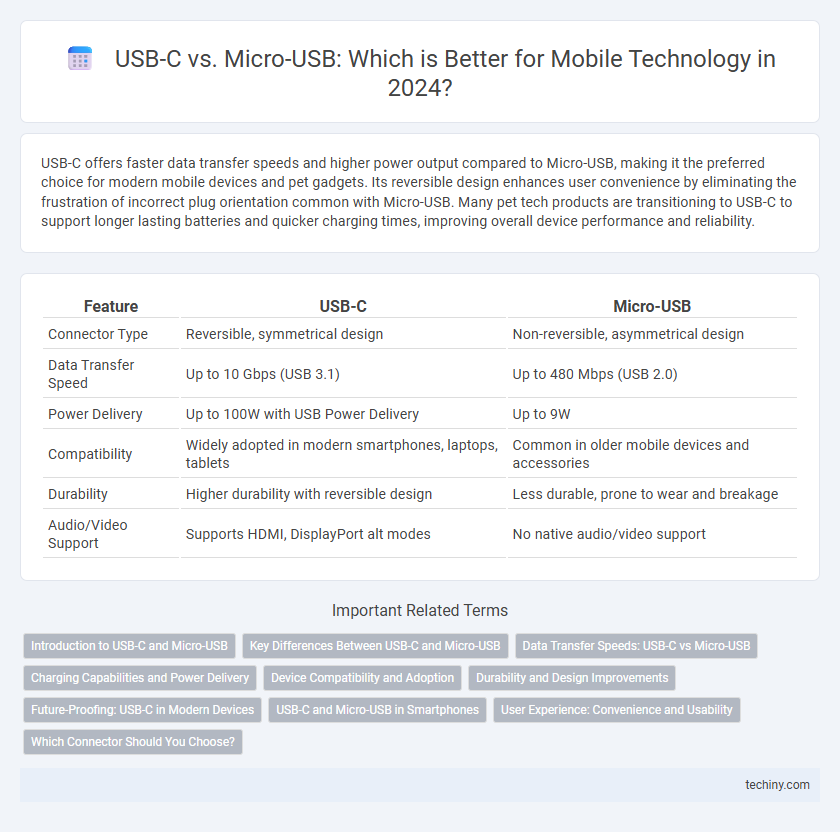USB-C offers faster data transfer speeds and higher power output compared to Micro-USB, making it the preferred choice for modern mobile devices and pet gadgets. Its reversible design enhances user convenience by eliminating the frustration of incorrect plug orientation common with Micro-USB. Many pet tech products are transitioning to USB-C to support longer lasting batteries and quicker charging times, improving overall device performance and reliability.
Table of Comparison
| Feature | USB-C | Micro-USB |
|---|---|---|
| Connector Type | Reversible, symmetrical design | Non-reversible, asymmetrical design |
| Data Transfer Speed | Up to 10 Gbps (USB 3.1) | Up to 480 Mbps (USB 2.0) |
| Power Delivery | Up to 100W with USB Power Delivery | Up to 9W |
| Compatibility | Widely adopted in modern smartphones, laptops, tablets | Common in older mobile devices and accessories |
| Durability | Higher durability with reversible design | Less durable, prone to wear and breakage |
| Audio/Video Support | Supports HDMI, DisplayPort alt modes | No native audio/video support |
Introduction to USB-C and Micro-USB
USB-C is a reversible connector standard designed to deliver faster data transfer speeds up to 10 Gbps and higher power output of 100W, making it ideal for modern mobile devices and laptops. Micro-USB, once the predominant charging port for mobile devices, supports slower data rates up to 480 Mbps and lower power delivery, limiting its efficiency with emerging high-performance gadgets. The transition to USB-C is driven by its enhanced functionality, universal compatibility, and improved durability compared to Micro-USB connectors.
Key Differences Between USB-C and Micro-USB
USB-C offers a reversible connector design and supports higher data transfer speeds up to 10 Gbps, compared to Micro-USB's 480 Mbps standard. USB-C also delivers greater power output, enabling faster device charging and compatibility with a wider range of electronics. Unlike Micro-USB, USB-C supports advanced protocols such as Thunderbolt 3 and DisplayPort, enhancing multimedia and peripheral connectivity.
Data Transfer Speeds: USB-C vs Micro-USB
USB-C supports data transfer speeds up to 10 Gbps with USB 3.1 or higher, significantly outperforming Micro-USB, which typically maxes out at 480 Mbps with USB 2.0. This eightfold increase in data transfer rate makes USB-C ideal for faster file transfers, high-resolution video streaming, and improved device synchronization. Devices equipped with USB-C benefit from enhanced performance and future-proof connectivity compared to the slower Micro-USB standard.
Charging Capabilities and Power Delivery
USB-C offers significantly faster charging capabilities compared to Micro-USB due to its higher power delivery rating, supporting up to 100 watts through USB Power Delivery (USB PD) standards. Micro-USB typically maxes out at 18 watts, limiting its efficiency for rapid charging and powering larger devices. The reversible design of USB-C also enhances usability while enabling more efficient energy transfer and device compatibility across modern smartphones and tablets.
Device Compatibility and Adoption
USB-C offers widespread compatibility across modern smartphones, tablets, laptops, and accessories, supporting faster data transfer and charging capabilities compared to Micro-USB. Micro-USB remains prevalent in older and budget devices but is gradually being phased out due to limited power delivery and slower speeds. The industry trend favors USB-C adoption for its universal connector design, enabling a seamless user experience across multiple device ecosystems.
Durability and Design Improvements
USB-C offers enhanced durability through a robust reversible connector design that withstands over 10,000 insertion cycles, compared to Micro-USB's asymmetrical design prone to wear and damage after fewer uses. The USB-C design supports a slimmer profile and symmetrical shape, enabling easier and more reliable connections that reduce strain on both cables and devices. Improvements in USB-C also include better shielding and reinforced connectors, resulting in longer-lasting cables and improved user experience for charging and data transfer in mobile technology.
Future-Proofing: USB-C in Modern Devices
USB-C offers superior future-proofing compared to Micro-USB due to its reversible design, higher data transfer speeds up to 10 Gbps, and support for power delivery up to 100 watts. Modern smartphones, tablets, and laptops increasingly adopt USB-C ports, ensuring compatibility with emerging accessories and faster charging standards. Widespread industry adoption and standardized protocols position USB-C as the dominant interface for the next generation of mobile technology devices.
USB-C and Micro-USB in Smartphones
USB-C offers faster data transfer speeds up to 10 Gbps compared to Micro-USB's maximum of 480 Mbps, enhancing smartphone performance and file management. Its reversible design improves user convenience over Micro-USB's asymmetrical connector, reducing wear and connection errors in daily smartphone use. USB-C also supports higher power delivery, enabling faster charging and compatibility with a wide range of modern devices and accessories.
User Experience: Convenience and Usability
USB-C offers a superior user experience compared to Micro-USB due to its reversible design, eliminating the frustration of incorrect cable orientation. It supports faster data transfer and charging speeds, enhancing overall convenience for mobile users. The universal adoption of USB-C across devices simplifies connectivity, reducing the need for multiple cables and adapters.
Which Connector Should You Choose?
When deciding between USB-C and Micro-USB, USB-C offers faster data transfer speeds up to 10 Gbps and supports higher power delivery, making it ideal for charging modern smartphones and tablets efficiently. Its reversible design enhances user convenience compared to the outdated, one-way Micro-USB connector, which maxes out at USB 2.0 speeds and limited power capacity. Choosing USB-C ensures future-proof compatibility with a wide range of mobile devices, laptops, and accessories, while Micro-USB remains suitable mainly for older or budget devices.
USB-C vs Micro-USB Infographic

 techiny.com
techiny.com